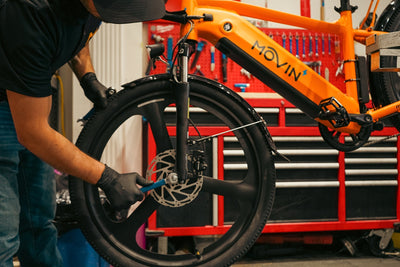Safety isn’t negotiable on an electric bike. Ebike brakes face unique demands: heavier frames and higher speeds require exceptional brake efficiency. In Canada, this challenge intensifies. Rain-slicked Vancouver streets, Montreal’s winter slush, and Alberta’s gravel trails demand brakes that won’t falter. At Movin’ Ebikes, we equip every model with Tektro HD-E3520 hydraulic disc brakes (160mm/180mm rotors) because we know Canadian conditions spare no compromise.
Bike Brake Types Explained: Which Suits Your Ride?
Rim Brakes (V-Brakes)
These classic bike brake types clamp pads onto wheel rims. While lightweight and simple, they’re ill-suited for Canadian ebikes. The disadvantage of V-brake systems? Weak wet-weather performance and inadequate stopping power for heavy ebikes. Water on rims causes dangerous slippage – a dealbreaker for year-round riding.
Mechanical Disc Brakes
These conventional brakes use cables to squeeze pads against a rotor. A major upgrade over rim types, they deliver reliable all-weather performance and are easier on budgets. But cables stretch over time, requiring frequent adjustments. For fair-weather commuters, they’re a practical choice.
Hydraulic Disc Brakes
The best hydraulic brakes for ebike use sealed fluid lines for explosive stopping power with minimal hand effort. These electric bike disc brakes excel in Canadian extremes: self-adjusting pads, consistent -30°C to +30°C performance, and zero fade in rain or snow. Movin’ Ebikes uses these exclusively because brakes for electric bikes must be failsafe.
Regenerative Brakes
Some electric brake bike systems recover braking energy to extend range. But regenerative brakes alone can’t stop a heavy ebike. They merely assist primary friction brakes (discs or rims). Think "bonus efficiency," not core safety.
Hydraulic vs Mechanical Disc Brakes: Key Differences
|
Feature |
Mechanical Disc Brakes |
Hydraulic Disc Brakes |
|
Stopping Power |
Good for urban flats |
Best brakes for ebike: 30% stronger, critical for hills |
|
Control |
Moderate lever effort |
Effortless modulation |
|
Maintenance |
Frequent cable adjustments |
Occasional fluid bleeds |
|
Weather Performance |
Reliable in rain |
Unbeatable in snow/slush |
|
Cost |
Budget-friendly |
Higher initial investment |
Choosing Your Ebike Brakes: 3 Factors for Canada
-
Riding Conditions
City commuting? Mechanical discs may suffice. Mountain trails? Best e-bike brakes = hydraulics. -
Weather Resilience
Discs beat rim brakes in wet/cold. Hydraulics dominate in ice and slush. -
Budget vs Performance
Mechanical: Value. Hydraulic: Premium safety for Canada’s extremes.
Critical Ebike Brake Upgrades & Maintenance
-
Pads Matter: Use metallic e bike brake pads for winter (better wet/ice bite).
-
Salt Warfare: Rinse rotors weekly to combat corrosion from road salt.
-
Tune-Ups: Mechanical brakes need monthly cable checks. Hydraulics require annual bleeds.
Pro Tip: Best brake pads for e bikes in Canada are sintered metal – they outlast organics in grit and cold.
FAQs Addressed In-Depth
Can I replace V-brakes with disc brakes?
Only if your frame has disc mounts. Otherwise, stick with rim brakes or upgrade your bike.
How do brakes on a bike work?
All types convert kinetic energy into heat via friction – but discs do it far more effectively under load.
Best type overall?
Hydraulic disc brakes – especially for Canada’s terrain.

